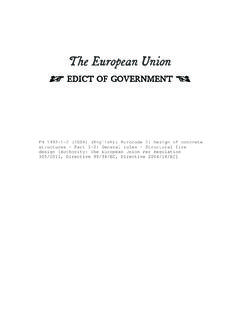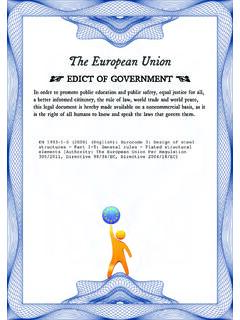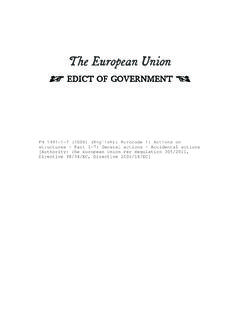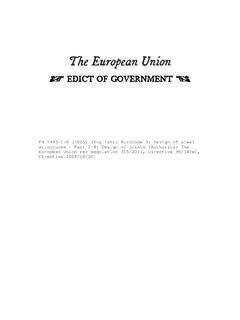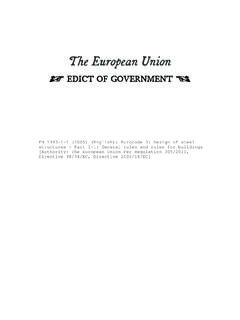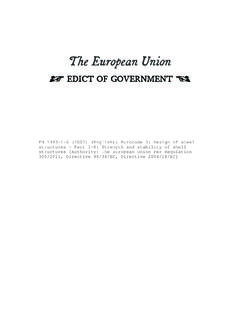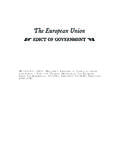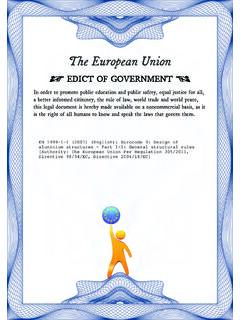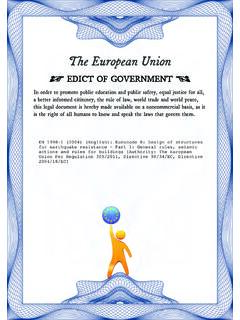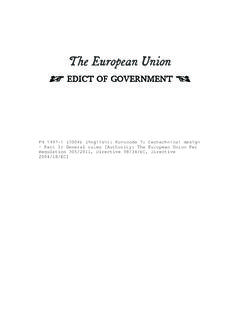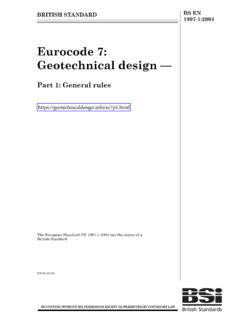Transcription of EN 1995-1-2: Eurocode 5: Design of timber structures ...
1 The European UnionIn order to promote public education and public safety, equal justice for all, a better informed citizenry, the rule of law, world trade and world peace, this legal document is hereby made available on a noncommercial basis, as it is the right of all humans to know and speak the laws that govern them. EDICT OF GOVERNMENT EN 1995-1-2 (2004) (English): Eurocode 5: Design of timberstructures - part 1-2: General - Structural fire Design [Authority: The European Union Per Regulation 305/2011,Directive 98/34/EC, Directive 2004/18/EC]EUROPEAN STANDARD EN 1995-1-2 NORME EUROPEENNE EUROpAISCHE NORM November 2004 ICS ; ; Incorporating corrigenda June 2006 and March 2009 Supersedes ENV 1995-1-2: 1994 English version Eurocode 5: Design of timber structures - part 1-2: General -Structural fire Design Eurocode 5: Conception et Calcul des structures en bois- part 1-2: GEmeralites - Calcul des structures au feu Eurocode 5: Entwurf, Berechnung und Bemessung von Holzbauten - Teil1-2: Allgemeine Regeln - Bemessung fOr den Brandfall This European Standard was approved by CEN on 16 April 2004.
2 CEN members are bound to comply with the CEI\jfCEI\JELEC Internal Regulations which stipulate the conditions for giving this European Standard the status of a national standard without any alteration. Up-to-date lists and bibliographical references concerning such national standards may be obtained on application to the Central Secretariat or to any CEN member. This European Standard exists in three official versions (English, French, German). A version in other language made by translation under the responsibility of a CEN member into its own language and notified to the Central Se!:::reltariat has the same status as the official versions. CEN members are the national standards bodies of Austria, Belgium, Cyprus, Czech Republic, Denmark, Estonia, Finland, France, Germany, Greece, Hungary, Iceland, Ireland, Italy, Latvia, Lithuania, Luxembourg, Malta, Netherlands, Norway, Poland, Portugal, Slovakia, Slovenia, Spain, Sweden, Switzerland and United Kingdom.
3 EUROPEAN COMMITTEE FOR STANDARDIZATION COMlTE EUROPEEN DE NORMALISATION EUROrAISCHES KOMlTEE FOR NORMUNG Management Centre: rue de Stassart, 36 B-1050 Brussels 2004 CEN All rights of exploitation in any form and by any means reserved worldwide for CEN national Members. Ref. No. EN 1995-1-2: 2004: E BS EN 1995-1-2: 2004 EN 1995-1-2: 2004 (E) Contents Foreword 4 Background of the Eurocode programme 4 Status and field of application of Eurocodes 5 National Standards implementing Eurocodes 5 Links between Eurocodes and harmonised technical specifications (ENs and ETAs) for products 6 Additional information specific to EN 1995-1-2 6 National annex for EN 1995-1-2 7 Section 1 General 9 Scope 9 Scope of Eurocode 5 9 1.
4 1 .2 Scope of EN 1995-1-2 9 Normative references 10 Assumptions 10 Distinction between principles and application rules 10 Terms and definitions 11 Symbols 11 Section 2 Basis of Design 14 Requirements 14 Basic requirements 14 Nominal fire exposure 14 Parametric fire exposure 14 Actions 15 Design values of material properties and resistances 15 Verification methods 16 General 16 Member analysis 17 Analysis of parts of the structure 18 Global structural analysis 19 Section 3 Material properties 20 General 20 Mechanical properties 20 Thermal properties 20 Charring depth 20 General 20 Surfaces unprotected throughout the time of fire exposure 21 Surfaces of beams and columns initially protected from fire exposure 23 General 23 Charring rates 26 Start of charring 27 Failure times of fire protective claddings 28 Adhesives 29 Section 4 Design procedures for mechanical resistance 30 General 30 Simplified rules for determining cross-sectional properties 30 General 30 Reduced cross-section method 30 Reduced properties method 31 Simplified rules for analysis of structural members and components 32 General 32 Beams 32 Columns 33 Mechanically jointed members 33 Bracings 34 Advanced calculation methods 34 Section 5 Design procedures for wall and floor assemblies 35 2 BS EN
5 1995-1-2: 2004 EN 1995-1-2: 2004 (E) General 35 Analysis of load-bearing function 35 Analysis of separating function 35 Section 6 Connections 36 General 36 Connections with side members of wood 36 Simplified rules 36 Unprotected connections 36 Protected connections 37 Additional rules for connections with internal steel plates 38 Reduced load method 39 Unprotected connections 39 Protected connections 41 Connections with external steel plates 41 Unprotected connections 41 Protected connections 41 Simplified rules for axially loaded screws 41 Section 7 Detailing 43 Walls and floors 43 Dimensions and spacings 43 Detailing of panel connections 43 Insulation 43 Other
6 Elements 43 Annex A (Informative) Parametric fire exposure 45 A1 General 45 A2 Charring rates and charring depths 45 A3 Mechanical resistance of members in edgewise bending 47 Annex B (informative) Advanced calculation methods 48 B1 General 48 B2 Thermal properties 48 B3 Mechanical properties 50 Annex C (Informative) Load-bearing floor joists and wall studs in assemblies whose cavities are completely filled with insulation 52 C1 General 52 C2 Residual cross-section 52 Charring rates 52 Start of charring 54 Failure times of panels 54 C3 Reduction of strength and stiffness parameters 56 Annex 0 (informative) Charring of members in wall and floor assemblies with void cavities 58 D1 General 58 02 Charring rates 58 D3 Start of charring 58 04 Failure times of panels 58 Annex E (informative) Analysis of the separating function of wall and floor assemblies 60 E 1 General 60 E2 Simplified method for the analysis of insulation 60 General 60 Basic insulation values 61 Position coefficients 62 Effect of joints 62 Annex F (informative) Guidance for users of this Eurocode part 68 3 BS EN 1995-1-2: 2004 EN 1995-1-2: 2004 (E) Foreword This European Standard EN 1995-1-2 has been prepared by Technical Committee CEN/TC250 "Structural Eurocodes", the Secretariat of which is held by BSI.
7 This European Standard shall be given the status of a National Standard, either by publication of an identical text or by endorsement, at the latest by May 2005, and conflicting national standards shall be withdrawn at the latest by March 2010. This European Standard supersedes ENV 1995-1-2: 1994. CENITC250 is responsible for all Structural Eurocodes. According to the CEN/CENELEC Internal Regulations, the national standards organizations of the following countries are bound to implement this European Standard: Austria, Belgium, Cyprus, Czech Republic, Denmark, Estonia, Finland, France, Germany, Greece, Hungary, Iceland, Ireland, Italy, Latvia, Lithuania, Luxemburg, Malta, Netherlands, Norway, Poland, Portugal, Slovakia, Slovenia, Spain, Sweden, Switzerland and United Kingdom.
8 Background of the Eurocode programme In 1975, the Commission of the European Community decided on an action programme in the field of construction, based on article 95 of the Treaty. The objective of the programme was the elimination of technical obstacles to trade and the harmonisation of technical specifications. Within this action programme, the Commission took the initiative to establish a set of harmonised technical rules for the Design of construction works which, in a first stage, would serve as an alternative to the national rules in force in the Member States and, ultimately, would replace them. For fifteen years, the Commission, with the help of a Steering Committee with Representatives of Member States, conducted the development of the Eurocodes programme, which led to the first generation of European codes in the 1980's.
9 In 1989, the Commission and the Member States of the EU and EFTA decided, on the basis of an agreement1 between the Commission and CEN, to transfer the preparation and the publication of the Eurocodes to the CEN through a series of Mandates, in order to provide them with a future status of European Standard (EN). This links de facto the Eurocodes with the provisions of all the Council's Directives and/or Commission's Decisions dealing with European standards ( the Council Directive 89/106/EEC on construction products - CPD and Council Directives 93/37/EEC, 92/50/EEC and 89/440/EEC on public works and services and equivalent EFTA Directives initiated in pursuit of setting up the internal market).
10 The Structural Eurocode programme comprises the following standards generally consisting of a number of Parts: EN 1990 EN 1991 EN 1992 EI\J 1993 EN 1994 EN 1995 EN 1996 EI\J 1997 Eurocode : Eurocode 1: Eurocode 2: Eurocode 3: Eurocode 4: Eurocode 5: Eurocode 6: Eurocode 7: Basis of Structural Design Actions on structu res Design of concrete structures Design of steel structures Design of composite steel and concrete structures Design of timber structures Design of masonry structures Geotechnical Design 1 Agreement between the Commission of the European Communities and the European Committee for Standardisation (CEN) concerning the work on EUROCODES for the Design of building and civil engineering works (BC/CEN/03/89).
